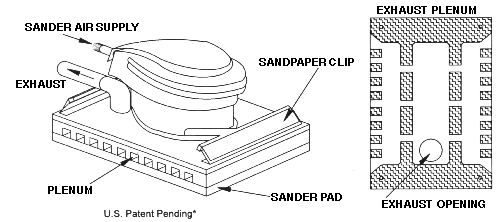Control of Wood Dust From Orbital Hand Sanders
1996
DHHS (NIOSH) Publication Number 96-126
Hazard
Orbital hand sanders have been found to create significant amounts of wood dust. Workers exposed to wood dusts have experienced a variety of adverse health effects such as eye and skin irritation, allergy, reduced lung function, asthma, and nasal cancer. Therefore, the National Institute for Occupational Safety and Health* (NIOSH) recommends limiting wood dust exposures to prevent these health problems.
Controls
NIOSH researchers found that the wood dust generated by orbital hand sanders is often poorly controlled. To address this problem, researchers designed and tested a new control system for these hand sanders that significantly reduced dust emissions.
Dust Control System
Orbital hand sanders are extensively used in woodworking processes. The dust from these sanders is generally not controlled although some are equipped with dust removal capabilities. However, even the sanders having dust removal do not effectively control the wood dust generated by the sanding operation. Therefore, a new control approach was developed. A Dust Control Plenum was designed and tested on an orbital sander.(See ILLUSTRATION) The plenum fits between the sanding pad and the sander body and has a series of exhaust slots along its edges. An exhaust connection on the top of the sander pad connects the plenum with a vacuum source. Laboratory tests show that the plenum reduces wood dust emissions by approximately 90 percent. The plenum does not interfere with the operator’s activities, requires no special maintenance, is inexpensive to operate, and can be used on any sander, pneumatically or electrically powered. This dust control device is not currently commercially available. Call NIOSH for more information.
*NIOSH is the Federal agency responsible for conducting research and making recommendations for preventing work-related illness and injuries. HAZARD CONTROLS are based on research studies that show reduced worker exposure to hazardous agents or activities.
Illustration: Dust Control Plenum for Orbital Hand Sanders

This document is one in a series of seven HAZARD CONTROLS concerning wood dust control techniques listed below that are available free upon request from NIOSH:
- HC4 Control of Wood Dust from Horizontal Belt Sanders
- HC5 Control of Wood Dust from Shapers
- HC6 Control of Wood Dust from Automated Routers
- HC7 Control of Wood Dust from Large Diameter Disc Sanders
- HC8 Control of Wood Dust from Random Orbital Hand Sanders
- HC9 Control of Wood Dust from Orbital Hand Sanders
- HC10 Control of Wood Dust from Table Saws
Acknowledgments
The principal contributors to this HAZARD CONTROLS are Jennifer L. Topmiller, Division of Physical Sciences and Engineering, and Jerome P. Flesch, Education and Information Division, NIOSH.
This document is in the public domain and may be freely copied or reprinted. NIOSH encourages all readers of this HAZARD CONTROLS to make it available to all interested employers and workers.
Control of Wood Dust From Orbital Hand Sanders [PDF – 165 KB]
